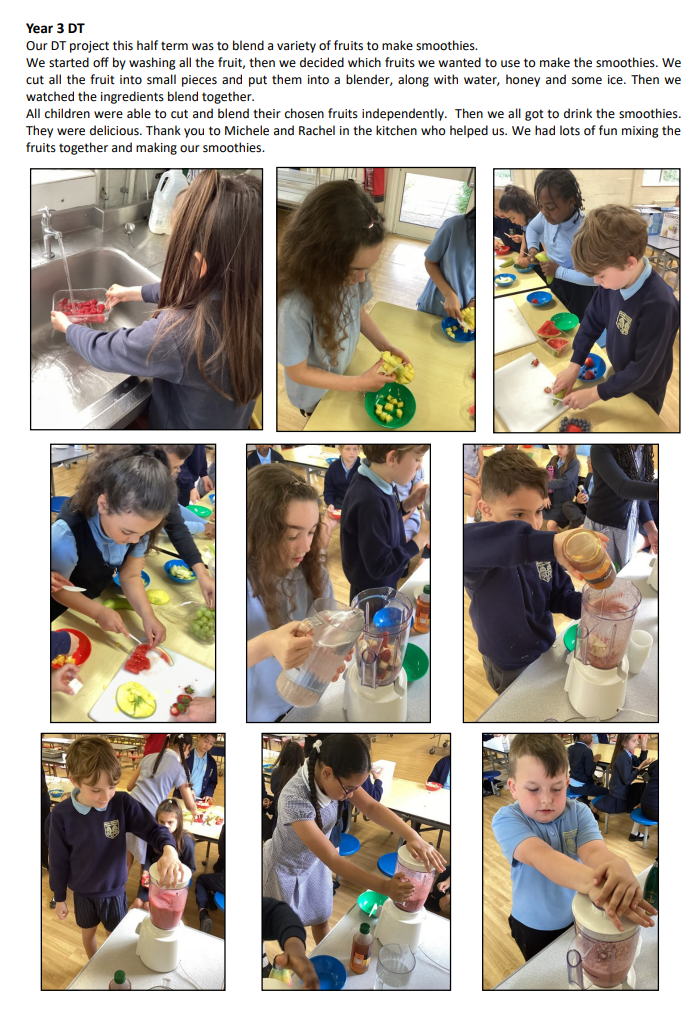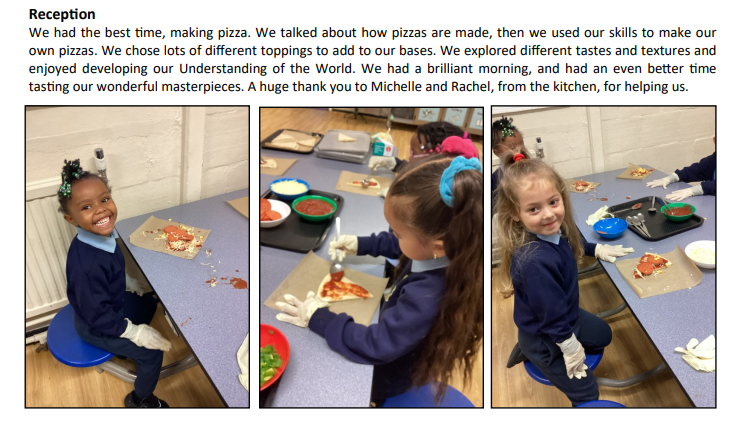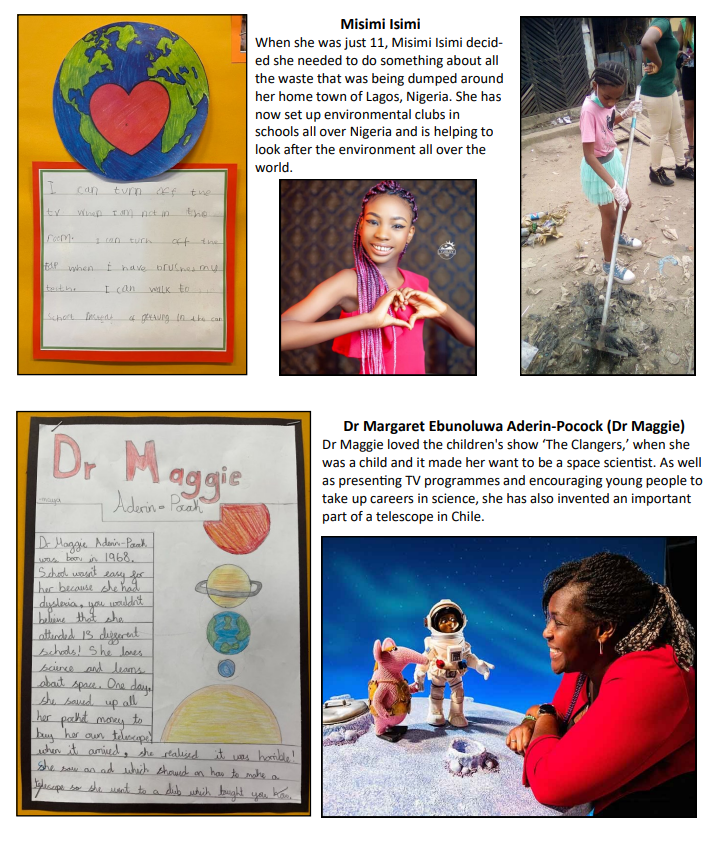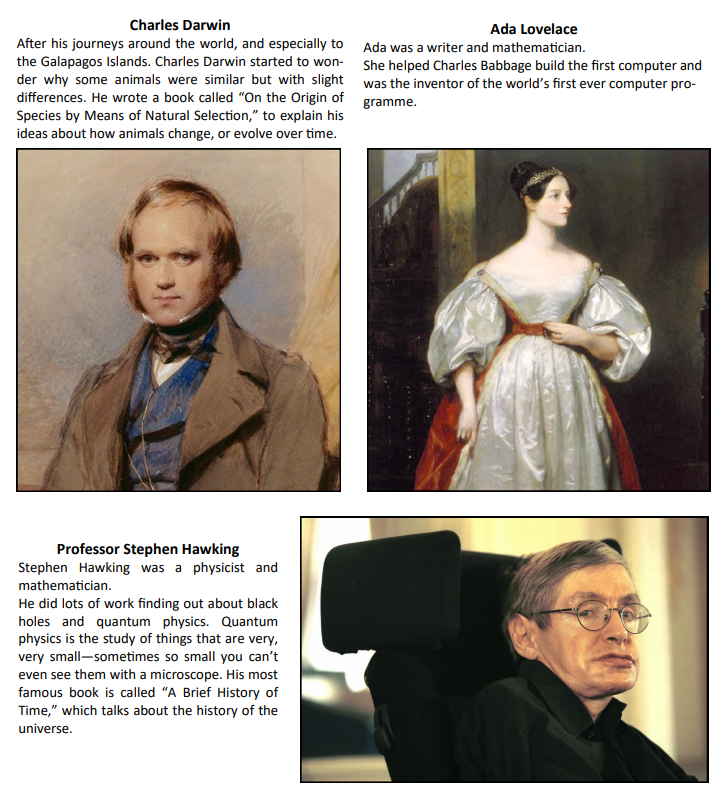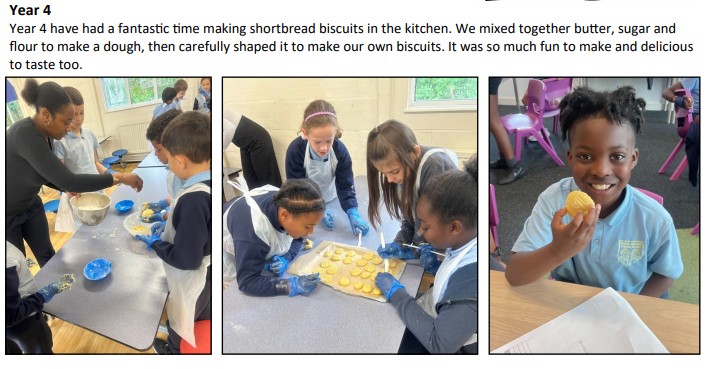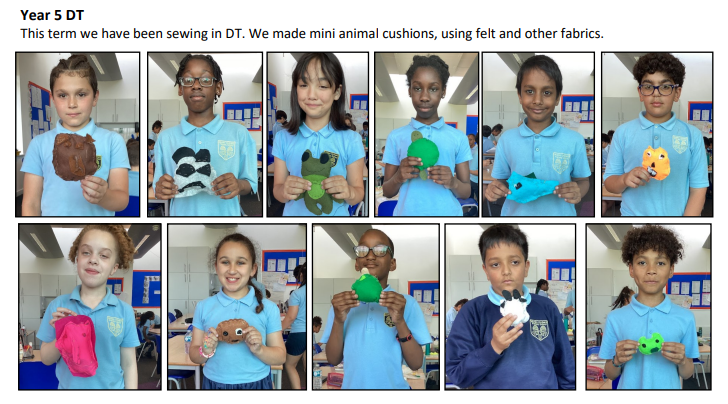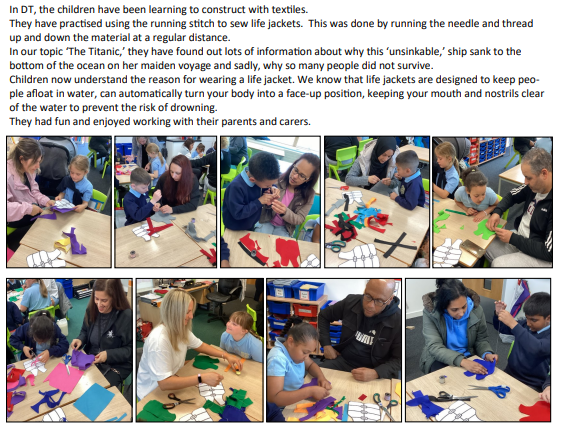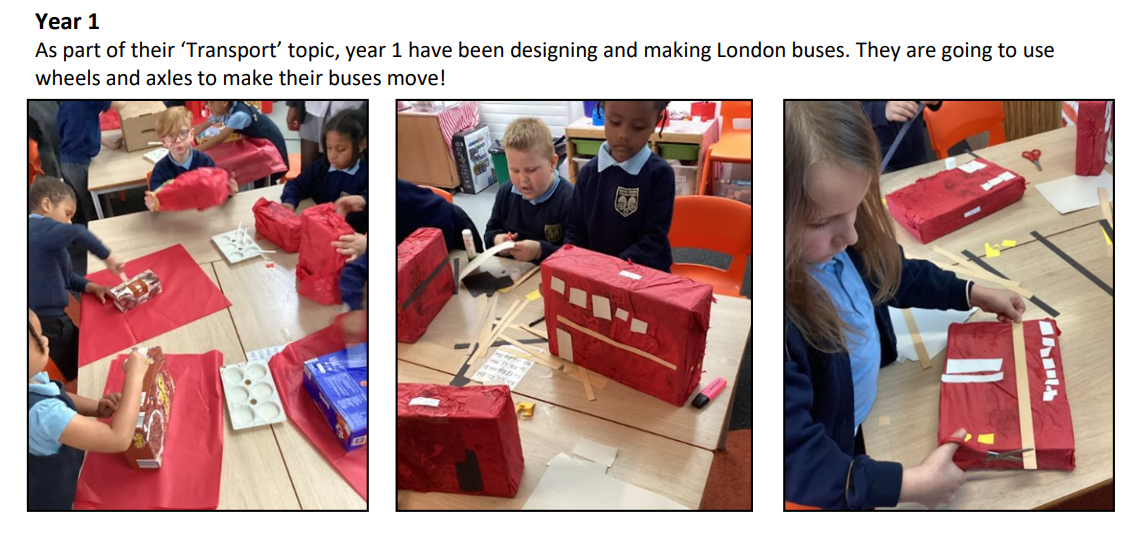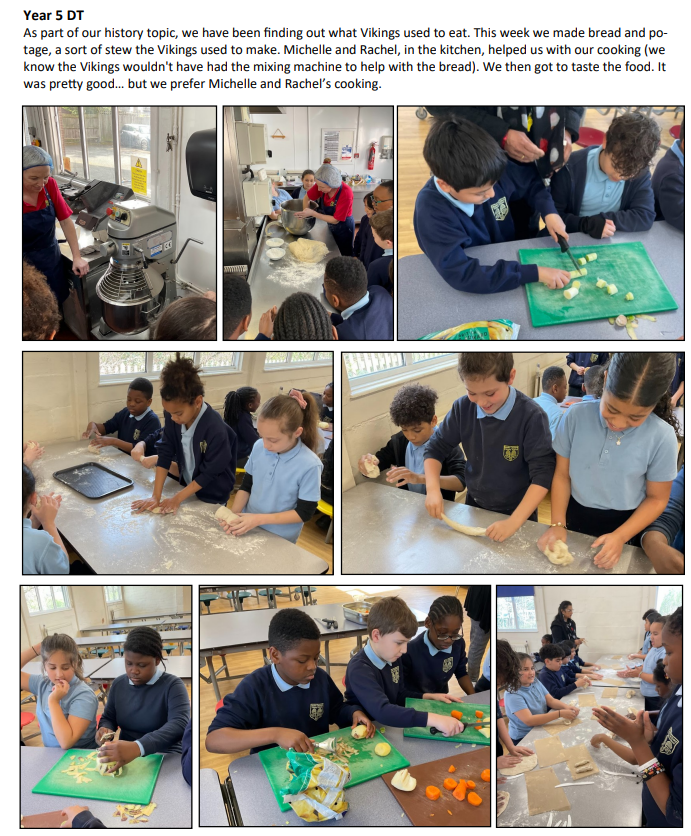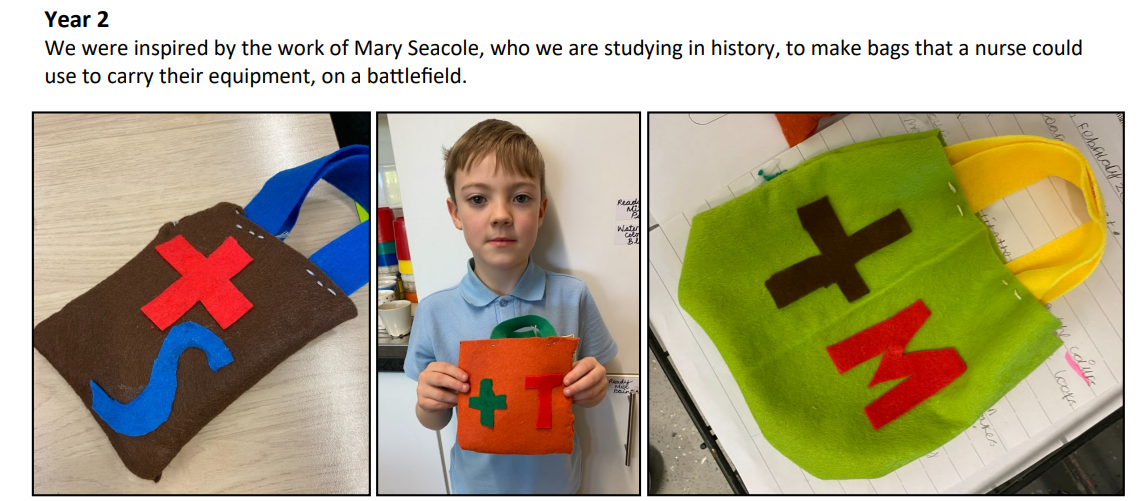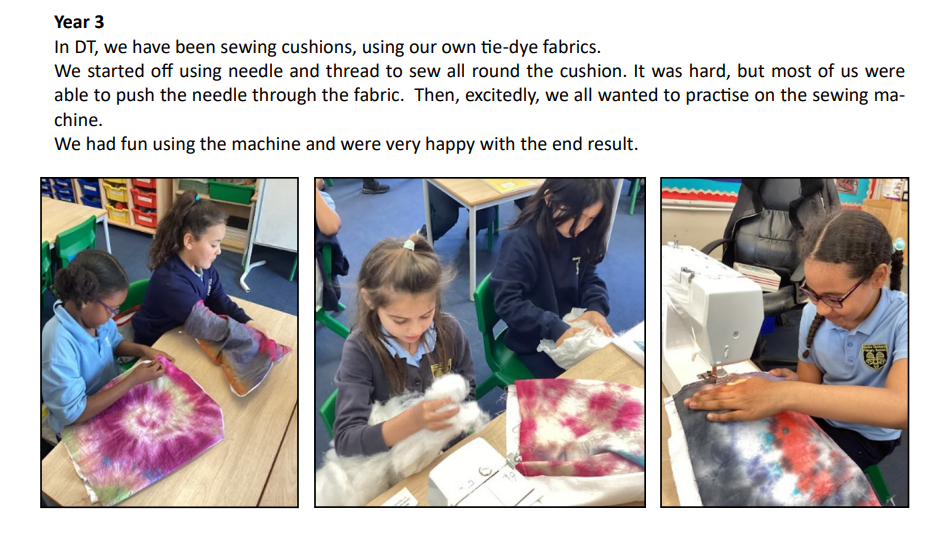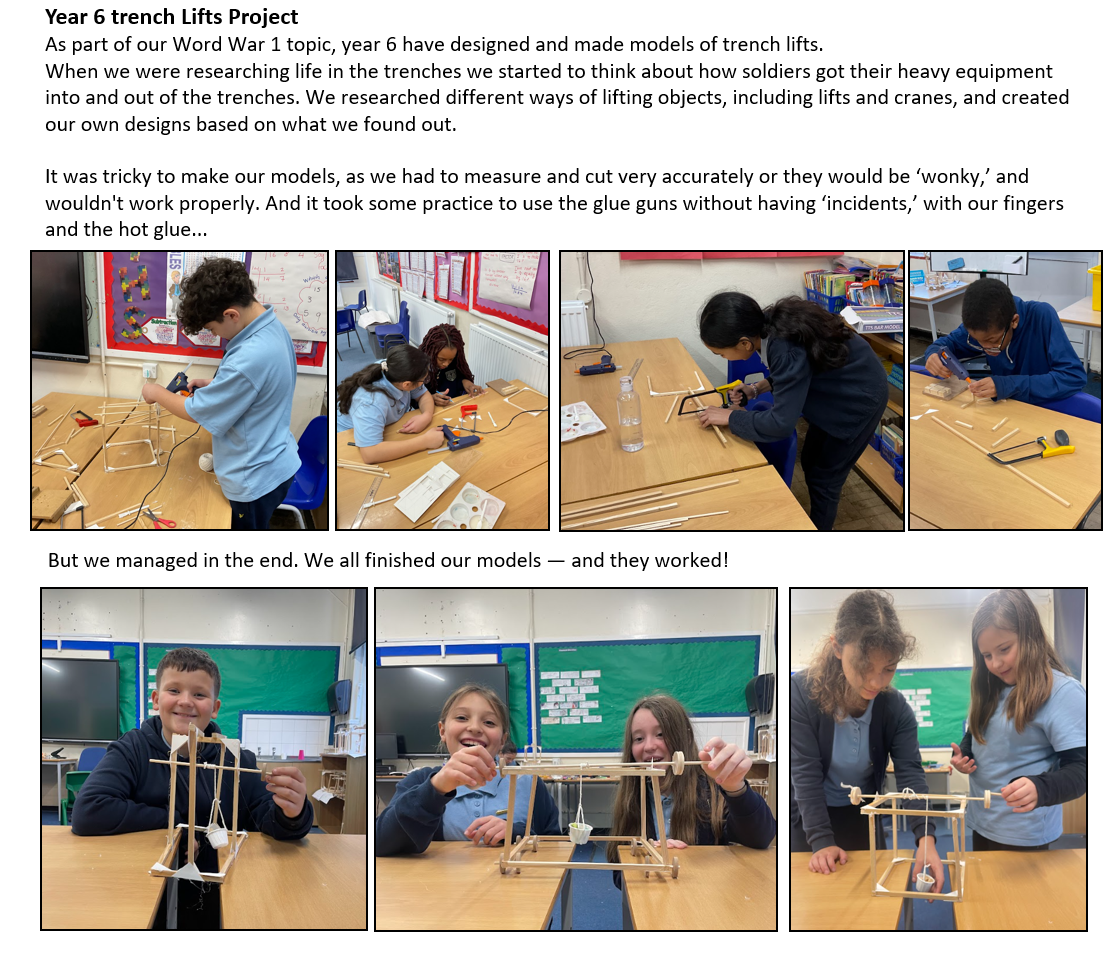DT
At Monks Orchard we help to prepare our children for the fast-paced ever-changing world by providing them with a range of opportunities for Design Technology. We link our Design Technology activities to the rest of our curriculum, to broaden children’s knowledge and to use their skills to create meaningful products. We carefully track the skills children need so that each one taught, builds upon prior learning and extends their knowledge. From designing structures, products and nutritional meals, to investigating mechanisms and electrical circuits, our children will be taught how to think creatively and critically, to prepare them for a career in Design Technology in the future.
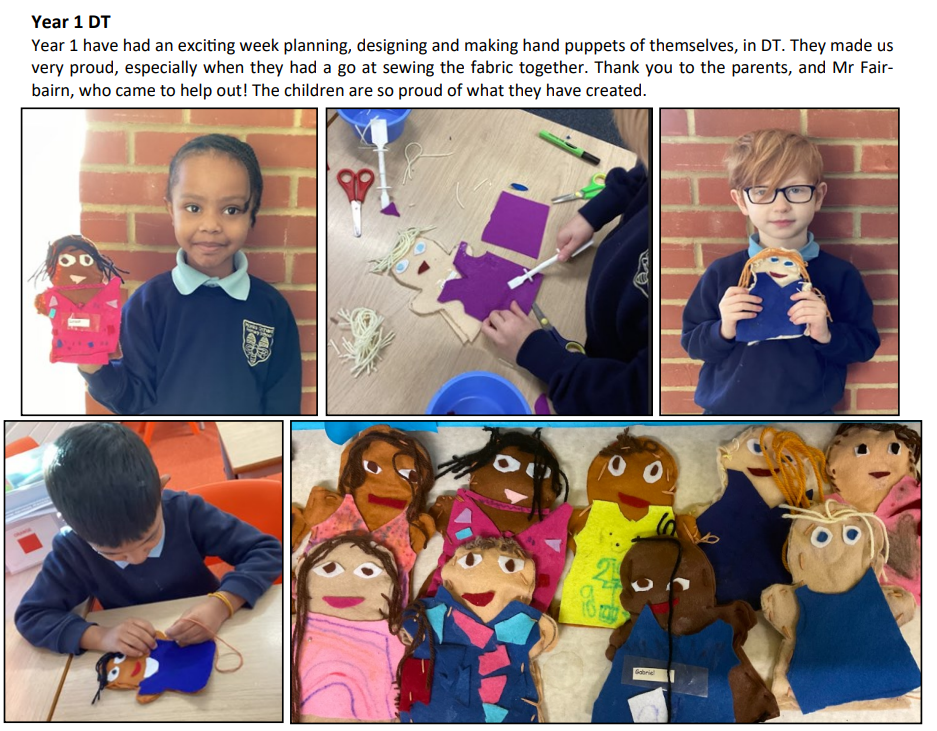 Progression in DT
Progression in DT
NB. Skills progression adapted from: Design and Technology Progression Framework (Design and Technology Association National Curriculum Expert Group for D&T)
EarlY years
| Nursery |
|
|
|
||
| Reception |
Year 1
|
Designing |
Understanding contexts, users and purposes |
|
| Generating, developing, modelling and communicating ideas |
|
|
| Making | Planning |
|
| Practical skills and techniques |
|
|
| Evaluating | Own ideas and products |
|
| Existing products |
Explore:
|
|
| Technical Knowledge | Making products work |
Know:
|
| Cooking and Nutrition | Where food comes from |
Know:
|
| Food preparation, cooking and nutrition |
Know:
|
Year 2
| Designing | Understanding contexts, users and purposes |
|
| Generating, developing, modelling and communicating ideas |
|
|
| Making | Planning |
|
| Practical skills and techniques |
|
|
| Evaluating | Own ideas and products |
|
| Existing products |
Explore:
|
|
| Technical Knowledge | Making products work |
Know:
|
| Cooking and Nutrition | Where food comes from |
Know:
|
| Food preparation, cooking and nutrition |
Know:
|
Year 3
| Designing | Understanding contexts, users and purposes |
|
| Generating, developing, modelling and communicating ideas |
|
|
| Making | Planning |
|
| Practical skills and techniques |
|
|
| Evaluating | Own ideas and products |
|
| Existing products |
Investigate and analyse:
|
|
| Key events and individuals |
|
|
| Technical Knowledge | Making products work |
Know:
|
| Cooking and Nutrition | Where food comes from |
|
| Food preparation, cooking and nutrition |
Know:
|
Year 4
| Designing | Understanding contexts, users and purposes |
|
| Generating, developing, modelling and communicating ideas |
|
|
| Making | Planning |
|
| Practical skills and techniques |
|
|
| Evaluating | Own ideas and products |
|
| Existing products |
Investigate and analyse:
|
|
| Key events and individuals |
|
|
| Technical Knowledge | Making products work |
Know:
|
| Cooking and Nutrition | Where food comes from |
|
| Food preparation, cooking and nutrition |
Know:
|
Year 5
| Designing | Understanding contexts, users and purposes |
|
| Generating, developing, modelling and communicating ideas |
|
|
| Making | Planning |
|
| Practical skills and techniques |
|
|
| Evaluating | Own ideas and products |
|
| Existing products |
Investigate and analyse:
|
|
| Key events and individuals |
|
|
| Technical Knowledge | Making products work |
Know:
|
| Cooking and Nutrition | Where food comes from |
Know:
|
| Food preparation, cooking and nutrition |
Know:
|
Year 6
| Designing | Understanding contexts, users and purposes |
|
| Generating, developing, modelling and communicating ideas |
|
|
| Making | Planning |
|
| Practical skills and techniques |
|
|
| Evaluating | Own ideas and products |
|
| Existing products |
Investigate and analyse:
|
|
| Key events and individuals |
|
|
| Technical Knowledge | Making products work |
Know:
|
| Cooking and Nutrition | Where food comes from |
Know:
|
| Food preparation, cooking and nutrition |
Know:
|
DT Projects
There are 3 specific Design and Technology projects through the year, one per term, per year group. Where possible these have been linked to class topics.
These projects should not be thought of as the only DT children do. Teachers are expected to identify opportunities for developing DT skills, knowledge and understanding, across the curriculum; linking to science, art and topic work where possible.
Each project will have a different focus:
- Food and drink technology
- Construction; including structures, mechanisms and control technology
- Constructing with textiles
Each project should follow the ‘Research – Design – Make – Evaluate’ structure.
Research
- understand the design brief
- think about who the product is for
- consider the needs of the consumer
- research Existing Products
- evaluate Existing Products
- know about the history of the product
- know about designers who have designed similar products
- conduct relevant market research
Design
- generate ideas
- use sketches, drawings, diagrams, annotations, IT, etc. to produce plan of product
- evaluate and modify plan
- select an appropriate range of materials
- select an appropriate range of tools
Make
- understand and follow safety and hygiene procedures/rules
- accurately measure, mark and shape materials
- accurately join and combine materials and components
- accurately apply a range of finishing techniques
- amend, adapt and solve problems during the making process
Evaluate
- talk about designs and products
- identify strength and areas for development
- critically evaluate suitability and effectiveness of product against design brief, and quality of construction
- consider views of other, including the consumer
- suggest improvements, changes
- undertake appropriate market research
Most activities are designed to be completed in small groups, usually of 3 or 4 children. But the size of the groups will depend on age and ability, and on the nature of the project.
| Autumn | Spring | Summer | |
|---|---|---|---|
| Nursery | Sandwiches (food) | Spring collage (textile) | A Car for Teddy (structures) |
| Reception | Pizzas (food) | Houses for the three little pigs (structures) | Sea creature collage (textile) |
| Year 1 |
Topic: All About Me Project: A glove puppet of me (textile) |
Topic: Treasure Project: A healthy packed lunch for a pirate (food) |
Topic: Transport Project: London Bus (structures) |
| Year 2 |
Topic: Living Things and Their Habitats Project: A moving minibeast, in its habitat, picture (structures) |
Topic: Significant People Project: Mary Seacole/ Florence Nightingale collage (textile) |
Topic: European Study (Spain) Project: A Spanish Feast (food) |
| Year 3 |
Topic: Stone Age to Iron Age Project: Iron Age houses (structures) |
Topic: Frozen Land Project: Polar animal soft toys (textile) |
Topic: Plants Project: Fruit smoothies (food) |
| Year 4 |
Topic: Ancient Egyptians Project: Hieroglyphic embroidery (textile) |
Topic: Ancient Rome Project: Rome siege weapons (structures) |
Topic: Rain Forest Project: Rain forest pastries (food) |
| Year 5 |
Topic: Space and the Space Race Project: Moon Buggies (structures) |
Topic: Civil rights Project: Civil rights banner (textile) |
Topic: Anglo Saxons, Celts and Vikings Project: Viking bread (food) |
| Year 6 |
Topic: World War I Project: Lift for a trench (structures) |
Topic: World War 2 Project: WW2 Dinner (food) |
Topic: Ancient Benin Project: Story-telling, wax print (Batik), tabard (textile) |
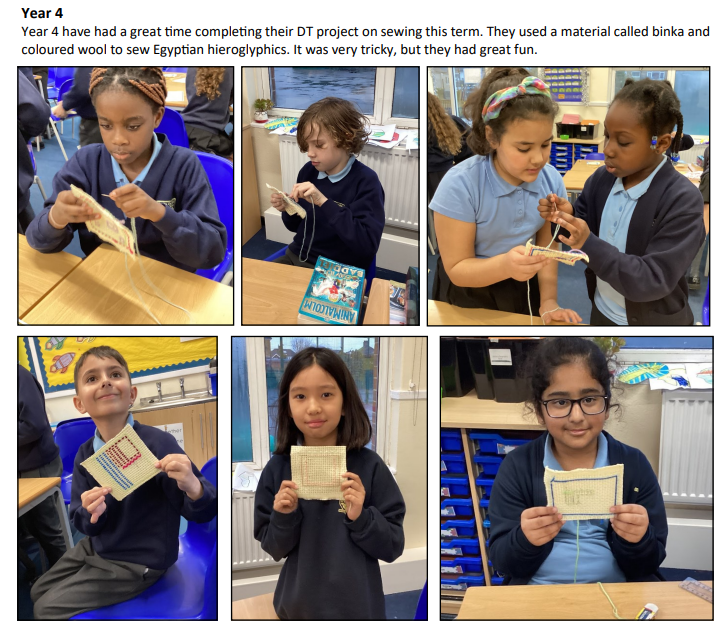
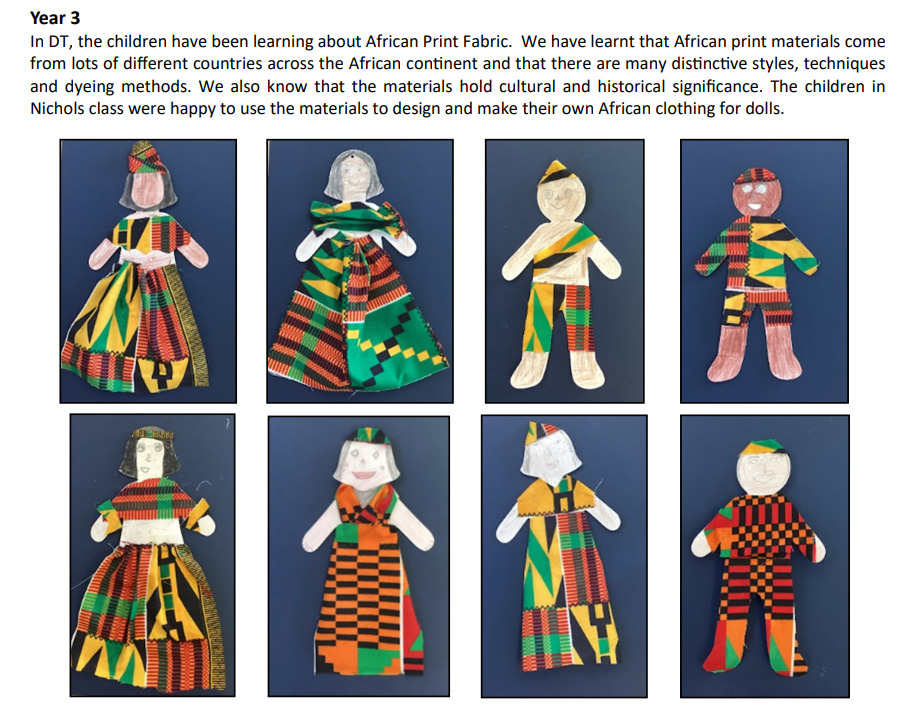
Nursery
| Project |
Sandwiches Choose ingredients for, make and eat sandwiches for a party (NB. Make sure you are aware of, and plan for, dietary requirements/ allergies.) |
|---|---|
| Topic link | N/A |
| DT Focus | Food and drink technology |
| Research |
What is a sandwich? When do people eat sandwiches? Difference between a snack and a meal. What have you had in a sandwich? What is your favourite sandwich? Taste a variety of breads and sandwich fillings. Talk about likes, dislikes, taste, texture, etc. Collect information about class' like and dislikes. |
| Design | Choose range of sandwiches to make. How many sandwiches will we need for the whole class? What ingredients will we need? Where could we get the ingredients? What tools we need? |
| Make |
Talk about hygiene and safety rules and the reasons for them. Count, measure and weigh ingredients. Choose appropriate tools and peel, grate, chop, cut, slice, spread ingredients |
| Evaluate | Eat the sandwiches (as part of a class party). Talk about the sandwiches and the process of making them. Which parts were easy/difficult. Likes, dislikes, things that were good, things we could do better or we would change. |
| Project |
Spring collage Design and make a spring collage using a variety of textiles |
|---|---|
| Topic link | N/A |
| DT Focus | Constructing with textiles |
| Research |
Research what happens in spring (weather, plants, animals, colours, etc.) Look at examples of textile collages and a variety of fabrics: talk about colours, textures, etc. Discuss which fabrics would be good and which would not be good for the project, and why? |
| Design |
Each child chooses one/two objects (eg. daffodil, lamb, tree, sun, etc.) to make for a whole class spring collage: talk about reasons for choices. Choose fabrics to use: thinking about colour, texture, etc. What tools will we need? |
| Make |
Talk about safety rules for using tools and the reasons for them. Mark out and cut shapes from a variety of materials. Assemble and join materials. |
| Evaluate | Talk about their object and the overall collage. What do they like about it? Why? What did they find easy or difficult? Things we could do better or we would change. |
| Project |
A car for teddy Design and make a car for a (teacher) chosen soft toy, using junk modelling materials |
|---|---|
| Topic link | N/A |
| DT Focus | Construction; including structures, mechanisms and control technology |
| Research | Look at and talk about a variety of cars, carriages, buses, trucks, etc. How do they move? Do people travel in them? Where do people sit/stand? How comfortable do you think they are? Which do you like? Why? Which do you think the toy would like? Why? |
| Design | Think about size and shape of toy. Will the toy sit/stand? How big will the car need to be? What shape should it be? What materials could we use? How would we join them? How will we decorate the car? What tools will we need? |
| Make |
Talk about safety rules for using tools and the reasons for them. Mark out, cut and shape a variety of materials. Assemble and join materials. Use finishing techniques (including those from art and design) |
| Evaluate | Talk about their car. What do they think about it? What do they like/not like? Does the toy fit? Do they think the toy like sit/is comfortable? Why? What did they find easy/difficult? Things we could better or change. |
Reception
| Project |
Pizzas Choose and prepare toppings for a pizza (NB. Make sure you are aware of, and plan for, dietary requirements/ allergies.) |
|---|---|
| Topic link | N/A |
| DT Focus | Food and drink technology |
| Research |
What is a pizza? Who has eaten pizza? What is your favourite pizza? Research where ingredients used to make pizza come from (plants, dairy, grains). Talm about how vegetables are fruit and vegetables are grown. Taste a variety of healthy toppings (fruit and vegetables) and identify them. Rate/evaluate the taste of each item with a view of including them as ingredients for a pizza. |
| Design | Design your pizza. Choose the toppings and draw a picture of what your pizza will look like (label pictures where appropriate). What ingredients will we need? Where could we get the ingredients? What tools we need? |
| Make |
Talk about hygiene and safety rules and the reasons for them. Count, measure and weigh ingredients. Choose appropriate tools and peel, grate, chop, cut, slice, spread ingredients |
| Evaluate | Eat the pizzas. Talk about the pizzas and the process of making them. Which parts were easy/difficult. Likes, dislikes, things that were good, things we could do better or we would change. Which ingredients would you use again, which would you not. |
| Project |
Houses for the three little pigs Design and make a (model) house for one of the three little pigs |
|---|---|
| Topic link | N/A |
| DT Focus | Construction; including structures, mechanisms and control technology |
| Research |
Read the story of the three little pigs. Look at photos/pictures of houses. Talk about the materials use to make the houses, and compare with the materials used by the three little pigs. Experiment with making three dimensional constructions out of different materials, such as paper, card, etc. Talk about which materials make a strong model and which are not strong enough. |
| Design |
Design a house (or home) for one of the three little pigs –taking into account that it must stand up on its own and be able to stand the wolf blowing on it. What materials could we use? How would we join them? How will we decorate the house? What tools will we need? |
| Make |
Talk about safety rules for using tools and the reasons for them. Mark out, cut and shape a variety of materials. Assemble and join materials. Use finishing techniques (including those from art and design) |
| Evaluate | Talk about their house. What do they think about it? What do they like/not like? Does it stand up on its own? If you blow on it, does it still stand up? What do you like/dislike about it? Why? What did they find easy/difficult? Things we could better or change. |
| Project |
Sea creature collage Design and make a collage of sea creatures, under the sea, using a variety of textiles |
|---|---|
| Topic link | N/A |
| DT Focus | Constructing with textiles |
| Research |
Research a variety of sea creatures (photos, books, videos, trip to aquarium). Look at examples of textile collages and a variety of fabrics: talk about colours, textures, etc. Discuss which fabrics would be good and which would not be good for the project, and why? |
| Design | Choose a sea creature to make as part of a class collage. Draw and colour your design. Think about which fabrics would be good to use; colour, texture, ease of use, etc. Label your picture with which fabrics you have chosen (add samples?). How will we join/fix the materials? What tools will we need? |
| Make |
Talk about safety rules for using tools and the reasons for them. Mark out and cut shapes from a variety of materials. Assemble and join materials. |
| Evaluate | Talk about their object and the overall collage. What do they like about it? Why? What did they find easy or difficult? Things we could do better or we would change. |
Year 1
| Project |
A glove puppet of me Design and make a glove puppet of myself |
|---|---|
| Topic link | All About Me |
| DT focus | Constructing with textiles |
| Research |
Look at self in mirror, describe features. Draw, colour, paint, self-portraits. Research puppets from different times and places, focusing on glove puppets. Talk about textiles used, construction, etc. |
| Design | Draw round hand to work out size puppet needs to be. Design puppet using hand outline as guide. Choose from a variety of textiles, considering, colour, texture, etc. Label your picture with which fabrics you have chosen (add samples?). How will we join/fix the materials? What tools will we need? |
| Make |
Talk about safety rules for using tools and the reasons for them. Mark out and cut shapes from a variety of materials. Assemble and join materials. Use finishing techniques. |
| Evalutate | Talk about their puppet. Is it the right size for their hand? What do they like about it? Why? What did they find easy/difficult? What could they do better or change? |
| Project |
A healthy packed lunch for a pirate Design and make a healthy packed lunch for a pirate, with pirate themed decoration. (optional: design and make a pirate’s packed lunch box) (NB. Make sure you are aware of, and plan for, dietary requirements/ allergies.) |
|---|---|
| Topic link | Treasure |
| DT Focus | Food and drink technology |
| Research | Talk about packed lunches. What is their purpose? What sort of things are in a packed lunch? Research sources of foods; animal or plant. Research healthy foods, know that fruit and vegetables are important in a healthy diet. Talk about what we should include to make sure our pirate’s packed lunch is healthy. Taste a selection of fruit and vegetables, rate/evaluate them according to taste, texture, etc. |
| Design | Design packed lunch. Choose items/foods to include. How can you make it look like it is for a pirate (shapes, decoration, etc.)? Draw labelled picture of what your packed lunch will include. Talk about where we will get the ingredients from. What tools will we need? |
| Make |
Talk about hygiene and safety rules and the reasons for them. Count, measure and weigh ingredients. Choose appropriate tools and peel, grate, chop, cut, slice, spread ingredients. |
| Evaluate | Eat packed lunch (pirate party) and talk about it. What did they like/dislike? Did it look like it was for a pirate? Why? What was easy or difficult? What could we do better or change? |
| Project |
London Bus Design and make a model London bus, with wheels and axles, using junk modelling materials |
|---|---|
| Topic link | Transport |
| DT Focus | Construction; including structures, mechanisms and control technology |
| Research | Research different modes of transport, focussing on the London bus. Talk about what buses are for, who uses them, what they look like (colour, shape, windows, doors, adverts, etc.). Talk about wheels and axles, how they work, construction, how they help the bus move. Practise making basic chassis, joining wheels to axles and to chassis. |
| Design | Draw a picture of what we want our model to look like. Talk about what materials we could use to make the model: thinking about practicality, strength, availability, etc. Talk about different ways to join our materials (glue, tape, staples, etc.) Experiment with different methods of joining. Which would/wouldn’t work? Which would look better in the final product? Why? Talk about what tools we will need to make our models. |
| Make |
Talk about safety rules for using tools and the reasons for them. Use a range of materials, tools and equipment. Mark out and cut shapes from a variety of materials. Assemble and join materials. Talk about what we are going to do first, next, etc. Use a range finishing techniques, including those from art and design. |
| Evaluate | Display the buses. As a class, talk about which buses you like, and explain why. Think about our own bus; what do we like about it? What don’t we like about it? What was easy or difficult? What could we do better next time? |
Year 2
| Project |
Moving mini-beast picture Design and make a moving picture of a mini-beast, in its habitat |
|---|---|
| Topic link | Living Things and Their Habitats |
| DT Focus | Construction; including structures, mechanisms and control technology |
| Research |
Look at a variety of cards and books with pop-ups and moving parts. Which do you like/not like? Why? Explore/take apart some of the moving parts. Which parts move? How do they move? How are they joined together? Talk about levers, hinges, linkages. Make simple card models of hinges, levers, etc. Research a variety of mini-beasts and their habitats (photos, books, videos, mini-safaris, etc.). Talk about how they move. Which mechanisms would you use to make flapping wings, moving legs, opening mouth, etc. |
| Design | Choose a mini-beast, and its habitat, to create a moving picture. Decide which part/s of the animal will move and which mechanism you will use to control the movement. Draw what you want you moving picture to look like, label which part/s will move and the mechanism to be used. |
| Make |
Talk about safety rules for using tools and the reasons for them. Use a range of materials, tools and equipment. Mark out and cut shapes from a variety of materials. Assemble and join materials. Talk about what we are going to do first, next, etc. Use a range finishing techniques, including those from art and design. |
| Evaluate | Create a gallery for the finished pictures. Explain how close their final product is to their initial design. Which bits worked well? Which bits didn’t work the way you wanted? Why didn’t they work? Which parts of the process were easy/difficult? Why? What would you change or do differently? |
| Project |
A bag for Mary Seacole/ Florence Nightingale Design and make a bag that Mary Seacole or Florence Nightingale could use to carry their supplies. |
|---|---|
| Topic link | Significant People |
| DT Focus | Constructing with textiles |
| Research |
Explore a variety of bags. What is it for? Who would use it? Look at sections, pockets, flaps, buttons, poppers, etc. What materials were used? How are the bags made? How are the components joined together (talk about sewing, glue, etc.)? Practice joining scrap fabrics together, using sewing, gluing and any other appropriate techniques. Which techniques worked wee/not well? Why? Explore a range of different fabrics. Which would be good for making bags? Why? Why would some not be good? Think about the jobs Mary Seacole and Florence Nightingale had. What sort of bags would they need? What would they have to carry in their bags? |
| Design | Children will create and decorate a simple fabric bag. Draw and colour a picture of what the bag will look like. How big will it need to be to hold objects. Think about materials, colours, fastening, decoration, etc. Label with the fabrics you will use (samples attached if possible). Talk about how we will join/fix the materials together. Make a list of tools you will need. |
| Make |
Talk about safety rules for using tools and the reasons for them. Mark out and cut shapes from a variety of materials. Assemble and join materials. Use finishing techniques. |
| Evaluate | Test bag, placing objects that may have been used by Mary Seacole or Florence Nightingale inside. Do they fit? Is it strong enough? Is it comfortable to hold/carry? Is the design/decoration effective? What do you like/not like about it? Why? |
| Project |
A Spanish Feast Prepare a simple savoury dish, to eat as part of a Spanish feast/meal (NB. Make sure you are aware of, and plan for, dietary requirements/ allergies.) |
|---|---|
| Topic link | European Study (Spain) |
| DT Focus | Food and drink technology |
| Research | Research the food of Spain. Tapas, gazpacho, paella, tortilla, seafood, spices, flavourings, etc. Try a selection of Spanish-style dishes. Identify them and talk about where they come from (plant, animal). Talk about likes and dislikes, justifying opinions referring to appearance, smell, taste, texture, etc. |
| Design | Using given recipes, identify ingredients and tools needed to make a tortilla and basic alioli. Make a list of what you will need and think about where you will get it from (use pre-made mayonnaise for alioli). Talk about what you will make first and why (alioli first, as it doesn’t involve cooking and is served cold). |
| Make |
Talk about and follow safety and hygiene rules for cooking. Follow a given set of instructions (recipe) to make alioli and tortilla. Name and use a variety of techniques and tools to prepare simple food (adult to do the cooking). Decide how you will evaluate the dishes (appearance, smell, taste, etc.) |
| Evaluate | Serve and eat the tortilla and alioli (with other simple, class favourite Spanish dishes). |
Year 3
| Project |
Iron Age houses Design and make a model of a typical iron age house |
|---|---|
| Topic link | Stone Age to Iron Age |
| DT Focus | Construction; including structures, mechanisms and control technology |
| Research | Research simple iron-age round houses. Design, materials (wattle and daub, thatch), practicalities (one room, share space with animals, fire in centre, etc.) Create a section of wattle and daub wall and/or thatch (using genuine materials where possible). |
| Design | Discuss materials to be used (eg. card, straw, string, etc.) Cannot use original materials to make model but what can we use that looks/feels like the original; experiment with different materials finishes. Draw picture of your iron age house, labelling materials and finishing techniques to be used. Select and list tools needed, and explain choices. |
| Make |
Talk about and follow safety rules. Measure, mark out, cut and shape materials and components. Assemble, join and combine materials and components with some accuracy. Apply a range of finishing techniques, including those from art and design, with some accuracy. |
| Evaluate | Identify the strengths and areas for development of their model, considering the views of others. What could you do next time to improve it? |
| Project |
Polar animal soft toys Create a stuffed/ soft toy of a polar animal |
|---|---|
| Topic link | Frozen Land |
| DT Focus | Constructing with textiles |
| Research |
Look at history of stuffed toys, starting with Steiff company (photos, videos, museum visit). Look at a variety of stuffed/ soft toys. Compare old and new stuffed toys. How are they made? What materials are used? How are the materials joined? How does the stuffing get inside? What is the stuffing made from? Research a variety of polar animals. |
| Design |
Choose your animal. Look at variety of materials to decide which you will use (considering colour, texture, ease of use, availability, etc.) Practise simple back stitch. Draw design for animal; thinking about materials, ease of cutting, stitching, stuffing (eg. no part too thin to get stuffing into) |
| Make | Talk about safety rules. Use a range of tools, techniques and materials to make soft toy. Adapt and amend design while constructing, to ensure is suits design, skill levels and materials. Apply a range of finishing techniques, including those from art and design, with some accuracy. |
| Evaluate | Arrange to share toys with younger year group (YR/Y1). Design and ask a set of questions for the younger children, to find out what they think of the toys. Identify the strengths and areas for development of their toys. Which parts of the process were easier/more difficult. |
| Project |
Fruit smoothies Combine a selection of fruits to prepare a brand new fruit smoothie. (NB. Make sure you are aware of, and plan for, dietary requirements/ allergies.) |
|---|---|
| Topic link | Plants |
| DT Focus | Food and drink technology |
| Research |
Try a selection of bought fruit smoothies. Evaluate, thinking about appearance, taste, texture, etc. Look at ingredients. Which are actual fruits? What else is included (sugar, colourings, preservatives, etc.)? Why the additional ingredients? Demonstrate making of a simple smoothie using three fruits and ice. Talk about where fruit comes from: plants, farms, orchards, etc. Which are grown in the UK/overseas, why? Try a selection of fruits (and vegetables). Think about taste, colour, texture, etc. Also try different combinations. Which work/ don’t work? Why? |
| Design | Choose 3 fruits (vegetables) to make your smoothie. Use knowledge from demonstrate to write recipe for your smoothie: including ingredients, tools needed and simple instructions. |
| Make |
Talk about and follow safety and hygiene rules for cooking. Use a range of techniques such as peeling, chopping, slicing, grating to prepare food Choose and use range of tools to prepare Follow own instructions to prepare fruit (make the smoothie |
| Evaluate |
Try own, and others’, smoothies. Evaluate appearance, smell, taste, texture, etc. Which smoothies/ingredients are most popular? Why? What was good/ not so good about your smoothie. Which techniques used for preparing smoothies were easy/ difficult/ need more practice. |
Year 4
| Project |
Hieroglyphic embroidery Create an embroidery sampler, using Ancient Egyptian hieroglyphics |
|---|---|
| Topic link | Ancient Egypt |
| DT Focus | Constructing with textiles |
| Research |
Research Ancient Egyptian hieroglyphics: history, design, meaning, etc. Practise writing a number messages/texts using hieroglyphics. Research embroidery samplers from Victorian period: move from samples of embroiderer’s work to exercise for children and adults. Look at examples of samplers; discuss content, design, layout, patterns, techniques, materials, etc. Practise simple embroidery skills and stitches (using Binca, transfer to plain material only if/when appropriate). |
| Design | Decide on a message/text and convert into hieroglyphics. Draw and colour plan of sampler, including hieroglyphics, decoration, patterns, etc. using Victorian examples to support. Identify stitches to be used for different sections of sampler. Decide which order to complete the different sections. |
| Make | Talk about safety rules. Use a range of tools, techniques and materials to make sampler (use plain material only if skills allow, otherwise stick with Binca). Adapt and amend design while constructing, to ensure is suits skill levels and materials |
| Evaluate | Create exhibition/display of samplers, which includes a series of questions to gather views. Identify the strengths and areas for development of their sampler. Which techniques/stitches were easier/more difficult. |
| Project |
Roman Siege Weapon Build a working model of a Roman siege weapon, based on an onager (catapult), to launch a projectile. |
|---|---|
| Topic link | Romans |
| DT Focus | Construction; including structures, mechanisms and control technology |
| Research | Research Roman onagers: use, construction, mechanism. Research other uses for cantilever mechanism. Practise making simple cantilever mechanisms, also methods to hold beam in tension then release. Experiment with different methods of joining wooden components, testing for strength and durability of bond. |
| Design | Children produce simple labelled diagram of their model onager (based on given basic design), identifying materials they will use. Record order in which they will complete tasks. Select tools they will use. Talk about/explain how their design will work. |
| Make |
Explain and follow safety rules and procedures. Accurately measure, mark, cut out and shape materials, using standard units of measurement. Accurately use a range of tools and techniques to create model, to assemble, join and combine materials. Accurately apply a range of finishing techniques. Adapt and modify, considering stability, strength, effectiveness, ability to carry out task, etc., and to solve problems as they arise. |
| Evaluate | Organise competition to see which onager can launch the projectile furthest. Use results of competition as one of a given set of criteria (eg. strength, stability, power, decoration, etc.) for evaluating onager. Identify strengths and areas for development. |
| Project |
Rain Forest Biscuits Bake a shortbread biscuit in the shape of a rainforest plant or animal (NB. Make sure you are aware of, and plan for, dietary requirements/ allergies.) |
|---|---|
| Topic link | Rain forest |
| DT Focus | Food and drink technology |
| Research |
Try a range of shortbread biscuits: different shapes and additional ingredients (eg. chocolate chips, raisins, etc.) Compare biscuits using given criteria (eg. appearance, shape, colour, decoration, smell, taste, texture), Identify which biscuit they most like/dislike and explain why, using given criteria. Know that flour is used in dough, that it is made from wheat, and that wheat is a plant which is grown on farms. Experiment forming given dough into a variety of shapes, and creating surface textures/patterns, using a variety of tools. Research a variety of rainforest animals and plants (photos, videos, books, etc.). |
| Design | Choose a rainforest plant or animal to represent in a biscuit. Draw picture of biscuit. Think about practicalities of making design in biscuit dough, what tools will you use, will you use any additional ingredients for specific parts of the design (eg. raisins for eyes). Make list of tool will need. |
| Make |
Talk about and follow safety and hygiene rules for cooking. Follow a given set of instructions (recipe) to make shortbread biscuit dough. Name and use a variety of techniques and tools to prepare and cook food. Apply finishing/decorating techniques. |
| Evaluate | Use given criteria (same as during research phase) to evaluate biscuits. Talk about strengths and areas for development, referring to criteria. |
Year 5
| Project |
Moon Buggies Design and build a (model) moon buggy, powered by an electric motor, which will carry a specified weight/object. |
|---|---|
| Topic link | Space and The Space Race |
| DT Focus | Construction; including structures, mechanisms and control technology |
| Research |
Research moon buggies (Lunar Roving Vehicles): design, construction, power, uses – and reasons for design decisions. (Also find out about the life of Ferenc Pavlics, designer of the LRV.) Research current electric cars and their designers/engineers Practise using electric motor to turn wheels, using pulley system and simple circuit, including a switch. |
| Design |
Draw labelled/annotated plans (cross-sections, exploded diagrams, etc.) for buggy, including circuit diagram. Select suitable materials for the task, and explain reasons for choices (strength, ease of use, aesthetic, etc.). Produce list of tools and materials needed, and basic step-by-step instructions. Design criteria for evaluating model (eg. Did the motor work/did the buggy move? Did it carry the weight? Stability, strength, aesthetics, ease of use, etc.). |
| Make |
Explain and follow safety rules and procedures. Accurately measure, mark, cut out and shape materials, using standard units of measurement. Accurately use a range of tools and techniques to create model, to assemble, join and combine materials. Accurately apply a range of finishing techniques. Adapt and modify, considering stability, strength, effectiveness, ability to carry out task, etc., and to solve problems as they arise. |
| Evaluate | Design and ask questions to get views of others. Evaluate model using pre-planned criteria, identifying and explaining reasons for strengths and areas for development. |
| Project |
Civil Rights Banners Design and make a banner, promoting civil rights, for use on a march |
|---|---|
| Topic link | Civil Rights |
| DT Focus | Constructing with textiles |
| Research |
Research banners used during protest/civil rights marches and demonstrations through history (also UK Trade Union banners). Talk about how the design, use of colour, text, pictures highlights and reinforces the underlying message. Explore a range of materials for use in making the banner, thinking about strength/durability, ease of cutting, joining, aesthetics, ‘standing out,’ etc. Also how banners are designed to withstand weather conditions, wind, etc. |
| Design | Choose issue to make banner for. Draw and colour design, considering effectiveness of communication of message, how it will be held, durability and ability to withstand weather conditions. Choose appropriate materials, explain choices, attach samples to design if possible. Produce step by step instructions, including list of tools needed. |
| Make |
Explain and follow safety rules and procedures. Accurately measure, mark, cut out and shape materials, using standard units of measurement. Accurately assemble, join and combine materials. Accurately use a range of tools and techniques to create banner. Accurately apply a range of finishing techniques. Adapt and modify, considering design, suitability of materials, clarity of message, etc., and to solve problems as they arise. |
| Evaluate | Hold march, to display banners. Design questionnaire for viewers to get their views. Evaluate the quality of the design, manufacture and success of their banner, taking account of the views of others, identifying and explaining reasons for strengths and areas for development. |
| Project |
Viking Bread Bake a loaf of bread, using an adapted Viking recipe (NB. Make sure you are aware of, and plan for, dietary requirements/ allergies.) |
|---|---|
| Topic link | Anglo Saxons, Celts and Vikings |
| DT Focus | Food and drink technology |
| Research |
Research the Viking diet and the types of bread they ate. Find a recipe for Viking bread, teacher to make samples for children to taste and rate/evaluate. Compare with modern types of bread: discuss similarities and differences. What ingredients are added to bread today? Which of those would the Vikings have used? Consider climate restrictions (eg. Would they have used olives? Why not?) Explore a selection of possible ingredients to add to bread (savoury and sweet); thinking about taste, texture, feel, combinations, effect of cooking, etc. Research action of yeast in bread making process. |
| Design |
Select ingredients to add to basic Viking bread recipe. Consider design of loaf, Viking pattern, shape, decoration, etc. Design criteria for evaluating loaf (eg. taste, texture, appearance, etc.). Write step-by-step instructions (recipe), including list of tools and materials needed. |
| Make |
Understand and explain safety and hygiene rules for cooking. Accurately weigh and measure ingredients, using a variety of units of measurement. Accurately use a range of techniques and tools to prepare, cook and serve food. Think carefully about presentation of food; colour, texture, arrangement, etc. Adapt to change appearance, taste, texture, etc, and to solve problems. |
| Evaluate | Arrange blind tasting of breads, with independent judges. Use pre-planned criteria to evaluate the meal, taking into account views of judges, identifying and explaining reasons for strengths and areas for development. |
Year 6
| Project |
Lift for a trench Design and build a model lift, to move heavy equipment into and out of a trench, using a mechanism to lift a specified weight/object. |
|---|---|
| Topic link | World War 1 |
| DT Focus | Construction; including structures, mechanisms and control technology |
| Research | Research WW1 trenches: reason for trenches, design, construction, measurements, etc. Talk about WW1 equipment, how would it have been moved into and out of trenches. Research examples of lifts, historical and modern (eg. lifts at The Colosseum, Louis XV’s flying chair, Elisha Otis’ safety lift), focussing on differing mechanisms used for raising and lowering. Experiment with different mechanisms for lifting; pulleys, levers, motors, counter-weights, etc. |
| Design |
Choose the mechanism to be used. Draw labelled/annotated plans (cross-sections, exploded diagrams, etc.) for model. Select suitable materials for the task, and explain reasons for choices (strength, ease of use, aesthetic, etc.). Produce list of tools and materials needed, and basic step-by-step instructions. Design criteria for evaluating model (eg. Did it lift the weight? Stability, strength, ease of use, etc.). |
| Make |
Explain and follow safety rules and procedures. Accurately measure, mark, cut out and shape materials, using standard units of measurement. Accurately use a range of tools and techniques to create model, to assemble, join and combine materials. Accurately apply a range of finishing techniques. Adapt and modify, considering stability, strength, effectiveness of mechanism, ability to carry out task, etc., and to solve problems as they arise. |
| Evaluate | Design and ask questions to get views of others. Evaluate model using pre-planned criteria, identifying and explaining reasons for strengths and areas for development. |
| Project |
World War 2 Dinner Create a meal using World War 2 rations (NB. Make sure you are aware of, and plan for, dietary requirements/ allergies.) |
|---|---|
| Topic link | World War 2 |
| DT Focus | Food and drink technology |
| Research |
Research rationing during WW2. Foods that were available/not available. The reasons some foods were not available or in short supply. that were rationed, how much the ration allowance was. Look at and discuss about one week’s ration allowance. Research role of Ministry for Food, look at recipes from WW2, and try some of the foods (eg. Lord Woolton’s Pie). Dig for Victory, and ways to supplement rations. Foods Research requirements of a healthy diet; nutrients (vitamins, minerals), fibre, etc. Discuss whether or not it was possible to eat a healthy diet on rations. |
| Design | Using the weekly ration allowances, plan a week’s worth of meals, for one person (using un-rationed foods to supplement). Choose one meal from the week’s plan to cook and eat. Write instructions for making the meal, including ingredients list. Select tools and materials needed. Design criteria for evaluating meal (eg. Did it stick to the rations? Does it include nutrients, etc. needed for a healthy diet? Taste, texture, appearance, etc.). |
| Make |
Understand and explain safety and hygiene rules for cooking. Accurately weigh and measure ingredients, using a variety of units of measurement. Accurately use a range of techniques and tools to prepare, cook and serve food. Think carefully about presentation of food; colour, texture, arrangement, etc. Adapt to change appearance, taste, texture, etc, and to solve problems, while preparing meal. |
| Evaluate | Eat meal, sharing with classmates. Design and ask questions to gain views of others. Use pre-planned criteria to evaluate the meal, identifying and explaining reasons for strengths and areas for development. |
| Project |
Story-Telling Fabric
|
|---|---|
| Topic link | Ancient Benin |
| DT Focus | Constructing with textiles |
| Research |
Research African wax print/batik fabrics (Kitenge, Kanga, Adire/Kampala). Colours, designs, patterns, uses, cultural significance, influences/impact of colonialism, etc. Research wax print/batik techniques and origins (Indonesia, Netherlands, West Africa). Practise simple wax print/batik techniques, using small fabric squares and a variety of application tools. |
| Design |
Listen to and explore a range of traditional Benin/Nigerian/West African stories. Choose an event, theme, character from one of the stories to represent in a design. Draw and colour design (on paper), bearing in mind practicalities of wax print/batik techniques, limited number of colours, and application tools available. Plan which application tools and which colours will be used for each part of the design. Re-design if necessary. Optional: Source/create simple tabard style, top pattern. Plan measure and cut pattern pieces to fit self. |
| Make |
Explain and follow safety rules and procedures. Accurately use a range of tools and techniques to create fabric. Accurately apply a range of finishing techniques. (Tabard: Accurately measure, mark, cut out and shape materials, using standard units of measurement. Accurately assemble, join and combine materials.) Adapt and modify, considering design, suitability of tools, representation of story, (fit, if making tabard), etc., and to solve problems as they arise. |
| Evaluate | Display materials and display prominently in school (hold fashion show if made into tabards). Design questionnaire for viewers to get views. Evaluate the quality of the design, manufacture and success of their fabric, taking account of the views of others, identifying and explaining reasons for strengths, areas for development. |
